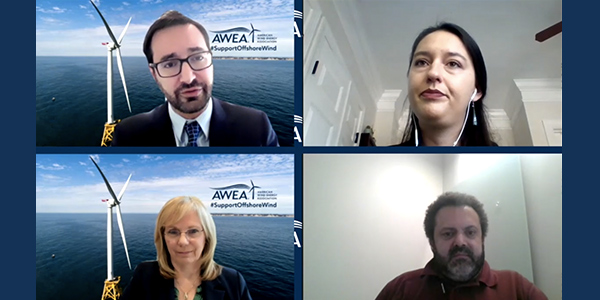Offshore wind advocates said Wednesday they are confident the industry will retain its bipartisan support regardless of the results of the U.S. elections this year.
“We are in a world now where utilities in Indiana are rushing forward building wind farms,” said Seth Kaplan, director of government and regulatory affairs for Ocean Winds, the joint venture between ENGIE and EDP Renewables that has partnered with Shell New Energies to sponsor Mayflower Wind.
“It’s a changed world, where there is a broad recognition that this is the kind of generation we are able to build now because of other concerns in terms of health, in terms of cost and such, that we are not seeing other types of large-scale generation getting built,” Kaplan told the American Wind Energy Association’s Offshore Windpower Virtual Summit.
As power plants retire, and as loads rise with new demand from electric cars and electrification of heating and cooling, “it is a truly bipartisan, across-the-board need for this large-scale generation source to move forward,” Kaplan said. “It is not wholly dependent on climate policy; it’s not wholly dependent on state policy. Those are all elements, but there is a unifying bipartisan need from the shipyards in Louisiana to the ports in Massachusetts to the folks who want new generation in New York City.”
Regulatory Push
Moderator Joshua Kaplowitz, senior counsel for GE Renewable Energy, noted that the federal regulatory regime governing offshore natural resources dates from nearly 100 years ago. Regulations specific to OSW have not been updated since the Bureau of Ocean Energy Management was created in 2011.
“We have come a long way — and I have been involved in this industry for 15 years now — but we continue to evolve. There is more work to be done,” said Geri Edens, counsel for Vineyard Wind, a joint venture between Copenhagen Infrastructure Partners and Avangrid Renewables.
BOEM has done a “tremendous job” trying to make regulations largely modeled on those for the oil and gas industry fit the needs of OSW development, with little experience beyond the failed Cape Wind project, Edens said. “So, it’s time to move on and try to start thinking about how the regulatory process can be improved.”
Edens said she hoped the agency, which announced a rulemaking in 2014 to update the regulations and provide more flexibility, will make more progress under a new administration.
“Now you see developers have to request numerous departures from the regulations because … all the things that go into gathering that data are onerous and not always feasible to submit at the same time that you submit a COP [construction and operations plan],” Edens said.
Claire Richer, federal affairs director at AWEA, noted acting BOEM Director Walter Cruickshank testified Sept. 22 before the Senate Energy and Natural Resources Committee that Congress has provided sufficient funding needed to hire the staff to assess all new lease areas and OSW proposals.
BOEM worked through the pandemic and held a series of public hearings over the summer on the 800-MW Vineyard Wind project and the 1-nautical-mile turbine spacing advocated by developers and recommended by the U.S. Coast Guard. (See Developers Seek 1-Mile Spacing for Vineyard Wind.)
Kaplowitz asked about BOEM’s authority under the Outer Continental Shelf Lands Act of 1953, “authority that was appended to Energy Policy Act of 2005 as a couple paragraphs to the end of one of the sections of a statute … that has primarily been an offshore drilling statute.” Are there changes that can be made to enhance BOEM’s authority with respect to offshore wind permitting? he asked.
“It’s really up to the developers to figure out what they want and what they think will be the best way forward,” Richer said. “A lot of folks in Congress want to help offshore wind. I think there’s a lot of bipartisan support. … If we want it, we need to push for it.”
Kaplan advised being “extremely careful” with making changes to a complicated regulatory structure, likening it to a game of Jenga, where if you pull any piece out it can cause the blocks to fall.
“Predictability is better than unpredictability,” Kaplan said.







